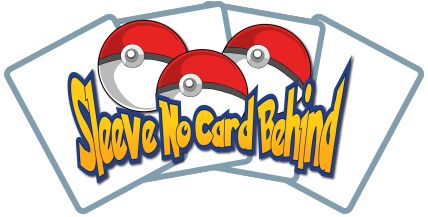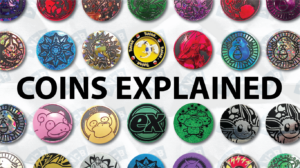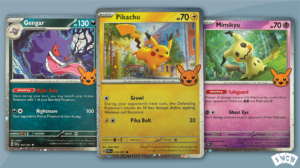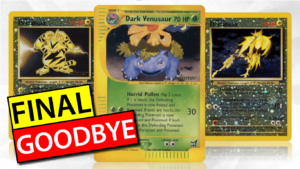-
By: Oliver Copeland
- Published:
- Last Updated: August 6, 2024
"The very first Pokémon cards ever released."
Table of Contents
What Are Bandai Carddass Pokémon Cards?
The Bandai Pocket Monsters Carddass trading cards, hereafter referred to as the “Carddass” trading cards, are a collection of cards released in Japan in 1996 and 1997 and are believed to be the first-ever Pokémon cards released.
The first set was released in two parts, and there was a red and green version of each card to collect. As reported by PokeBoon, 5 Carddass cards cost 100 yen, which would be less than $1 USD.
These cards were only obtained by using special CARDDASS vending machines. The cards were not sold in booster packs like most trading cards today.
Each card features artwork by Ken Sugimori, the original illustrator for the Pokémon franchise. Today, the cards are highly sought after and many sell for 4 figures when graded in a PSA 10, with the Prism Charizard selling for 5 figures.
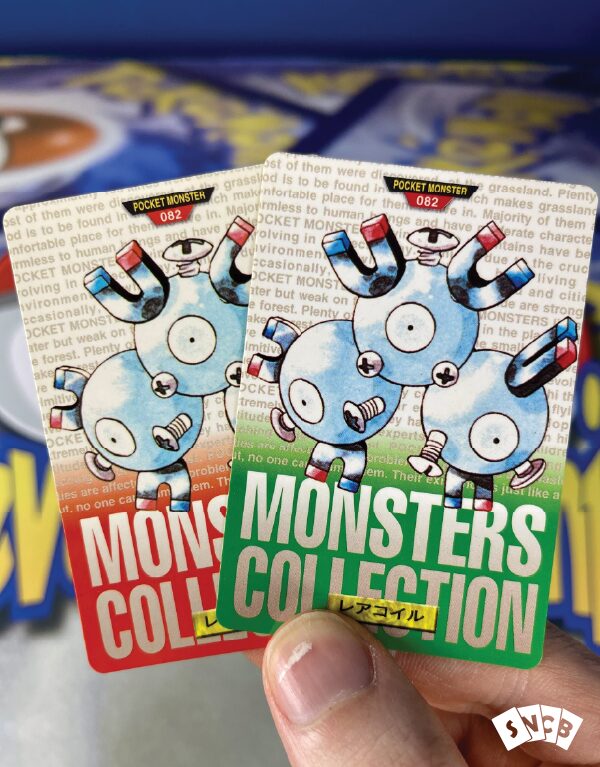
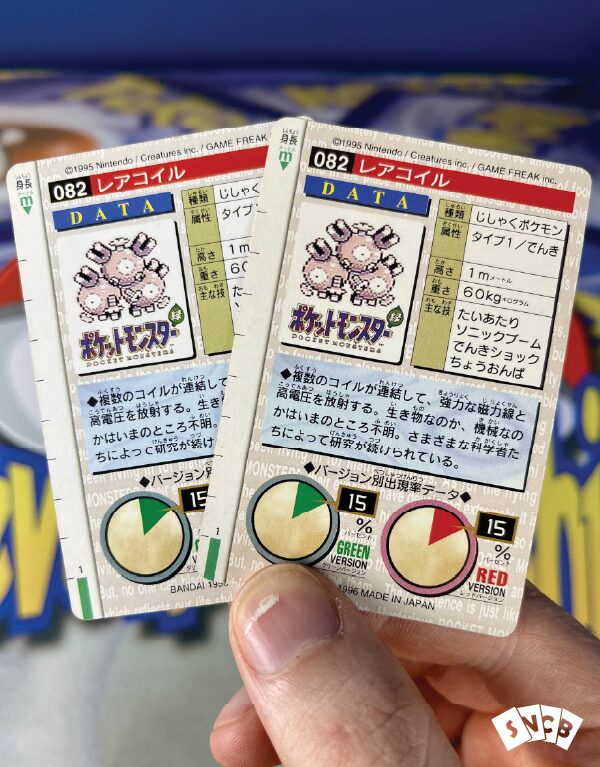
What Does ‘Carddass’ Mean?
‘Carddass’ is pronounced ‘Card-ass’, although some people like to say ‘Card-aws’ instead.
The inspiration for the name came from AMeDAS (Automated Meteorological Data Acquisition System), a Japanese system employed for collecting regional weather data. This weather system gathers information such as humidity, atmospheric pressure, temperature, etc.
If you look at the reverse side of a Carddass card, stats for the Pokémon are displayed in great detail, much like the AMeDAS system reports stats on the weather.
The concept behind Carddass was to serve as an informational resource for children, providing regional data for each Pokémon.
Carddass is a trademark registered by Bandai.
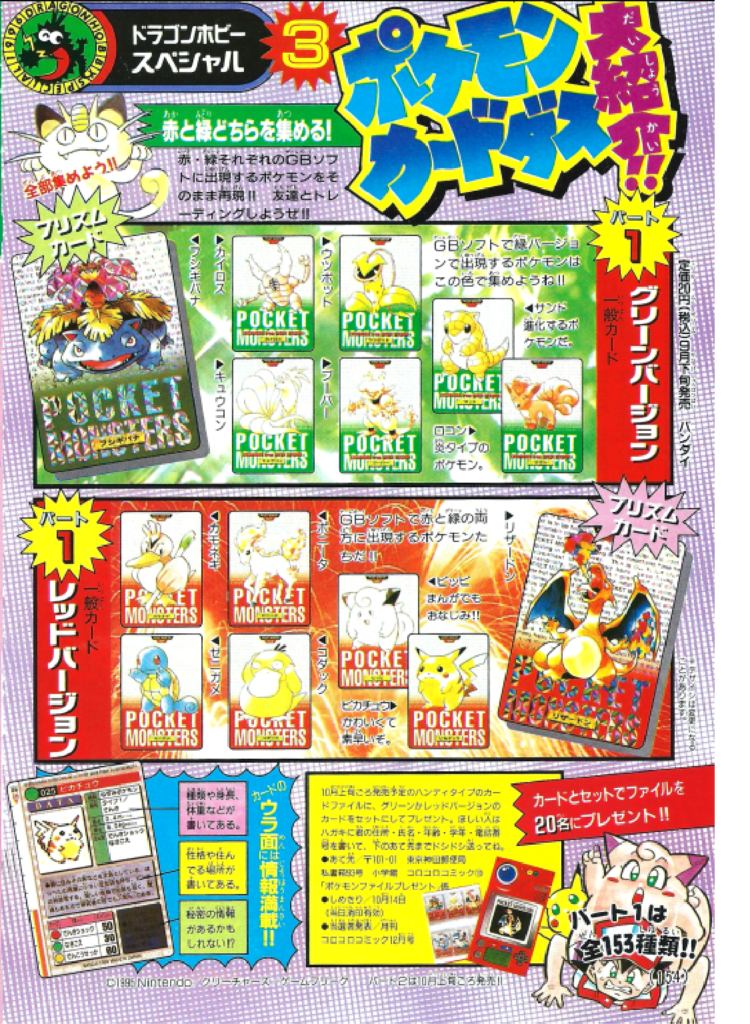
Sets and Release Dates
There are multiple sets of Pokémon Carddass cards, with a couple promotional and secret cards to consider as well.
Part 1+2
The initial set of CARDDASS cards (Part 1+2) is unique and indicative of the early stages of Pokémon. The front of the card says ‘POCKET MONSTER’ at the top, but the words ‘MONSTERS COLLECTION’ are much more prominent, taking up the entire lower third of the card. The reverse side of the cards displays stats for the featured Pocket Monster, as well as which GameBoy version they can be found in (Red Version or Green Version).
Another characteristic unique to only these cards is the original GameBoy game sprite represented on the back of the cards. Part 1 of the 1996 Carddass cards was released in September 1996, in Japan. These cards featured both red and green versions of all 151 Pokémon, plus two checklist cards and a Town Map card, for a total of 309 cards.
Part 2 was released the following month, in October. The cards themselves have no indication of whether they belong to Part 1 or Part 2.
11 of the cards from Part 1+2 feature additional artwork on the back illustrated by Benimaru Itoh. This artwork is very unique as it depicts the Pokémon in a mature and often unsettling light. More on this later.
Red Vs. Green Variants
The original Pokémon GameBoy games released in Japan were Red Version and Green Version, and while there were 150 Pokémon to collect, each game had a handful of exclusives.
For example, Ekans and Arbok were only available to catch in Pokémon Red Version. A player with Green Version would have to trade a friend with Red Version in order to collect their own Ekans and Arbok.
The 1996 CARDDASS cards represent this well. While each Pokémon has both a green and red CARDDASS card, some are marked with “EXCHANGED from RED VERSION” or “EXCHANGED from GREEN VERSION”.
In addition to this, some Pokémon had to be traded to evolve, but the game version did not matter. In this case, the red CARDDASS card will say “EXCHANGED from GREEN VERSION” and the green CARDDASS card will say “EXCHANGED from RED VERSION”.
Cards with “EXCHANGED from RED VERSION“:
- Ekans
- Arbok
- Oddish
- Gloom
- Vileplume
- Mankey
- Primeape
- Growlithe
- Arcanine
- Scyther
- Electabuzz
- Alakazam (Evolves from trade)
- Gengar (Evolves from trade)
- Machamp (Evolves from trade)
- Golem (Evolves from trade)
Cards with “EXCHANGED from GREEN VERSION“:
- Sandshrew
- Sandslash
- Vulpix
- Ninetales
- Meowth
- Persian
- Bellsprout
- Weepinbell
- Victreebel
- Magmar
- Pinsir
- Alakazam (Evolves from trade)
- Gengar (Evolves from trade)
- Machamp (Evolves from trade)
- Golem (Evolves from trade)
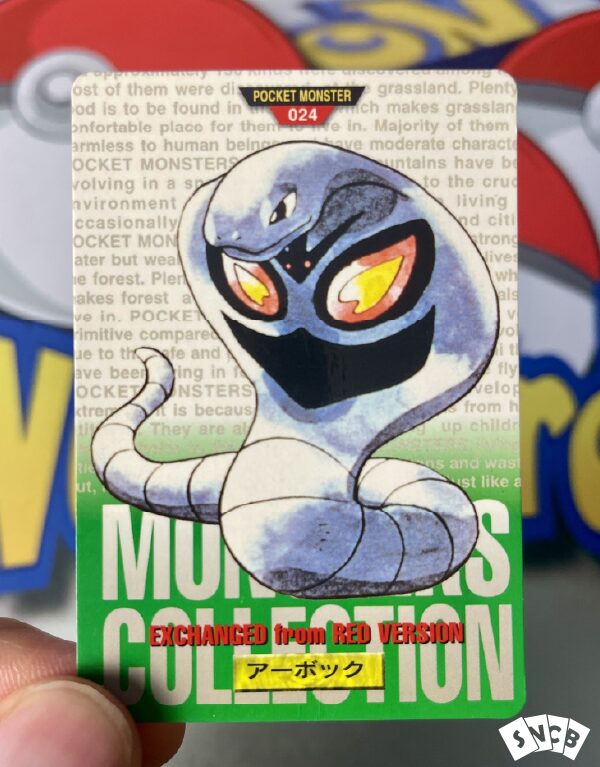
The English text in the background reads:
“…approximately 150 kinds were discovered among us. Most of them were discovered at the grassland. Plenty of food is to be found in the, which makes grassland comfortable place for them to live in. Majority of them are harmless to human beings and have moderate character. POCKET MONSTERS living in the mountains have been evolving in a special way. This is due to the crucial environment in which they have been living. They occassionally appear in a grassland and cities. POCKET MONSTERS living by the water side are strong against water but weak to fire. Small POCKET MONSTERS lives in the forest. Plentiful food is to be found in the place which makes forest a comfortable place for the small animals to live in. POCKET MONSTERS that have been living in the sea are very primitive compared to others. They had no need to evolve due to stable and confortable environment in whichl they have been living in for many centuries. As for the flying POCKET MONSTERS, their eyesight have developed extremely. It is because they had to find baits from high attitudes. They are also experts in raising up children by catching baits from the forest and grasslands. POCKET MONSTERS living in urban settings are affected to the problems of pollutions and waste but, no one can blame them. Their existence is just like a…”
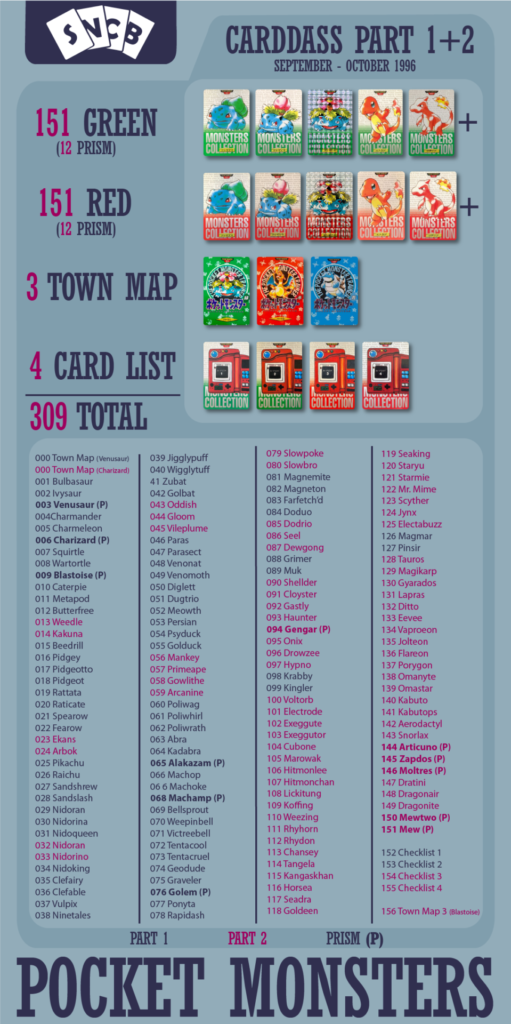
Part 1+2 Prism Cards
Of the original 309 CARDDASS cards, there are 24 prism cards available to collect. These are the first holofoil Pokémon cards to be released to the public and are highly sought after.
The prism cards are also stickers that can be peeled off the card stock. This applies to all prism CARDDASS cards in Parts 1-4.
Here is the list of Part 1+2 prism cards:
- Venusaur (Part 1)
- Charizard (Part 1)
- Blastoise (Part 1)
- Alakazam (Part 1)
- Machamp (Part 1)
- Golem (Part 1)
- Gengar (Part 2)
- Articuno (Part 2)
- Zapdos (Part 2)
- Moltres (Part 2)
- Mewtwo (Part 2)
- Mew (Part 2)
Each of these Pokémon has two prism cards, one red and one green. If you want a complete collection, you must collect all 24 prism cards.
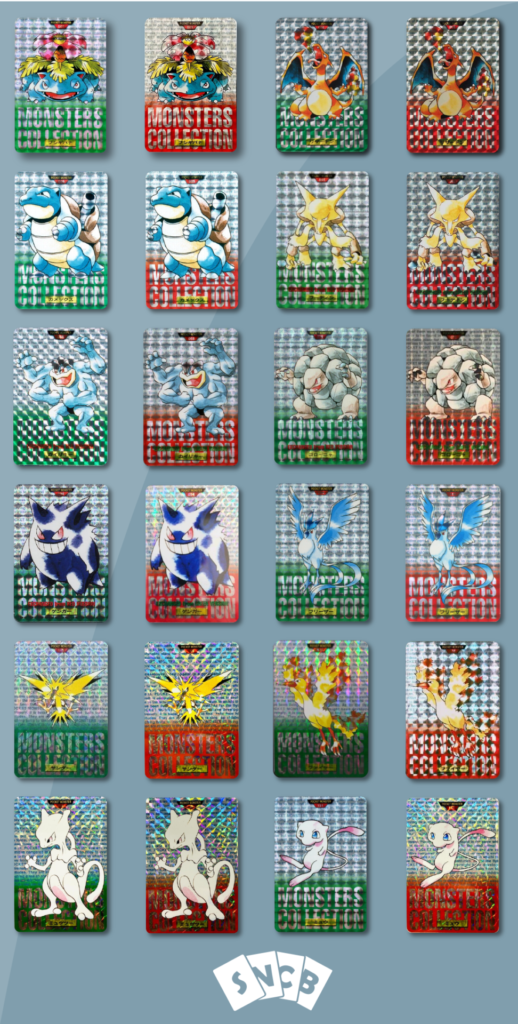
Part 3+4
The second set of CARDDASS cards (Part 3+4) underwent a drastic redesign when compared to the first set. The cards now say ‘POCKET MONSTERS’ at the bottom and the illustrations depict each Pocket Monster using its signature move.
This set was released in two parts. Part one was released April 1997, and Part 2 in June 1997.
Part 3+4 contains 151 cards and two secret cards, but no Town Map cards. The secret cards also have checklists on the back.
Many of the illustrations are much more dynamic and many depict multiple Pocket Monsters fighting, or sometimes coexisting.
The reverse side of the cards is heavily redesigned as well.
The Pocket Monster is now represented by an illustration matching the front of the card, instead of the GameBoy game sprite. The evolution line is shown, if applicable, and a diagram now displays also Blue Version, regarding the Pocket Monsters’ availability in-game.
Part 3+4 has 16 prism cards this time and one rainbow foil card. The only rainbow foil card is Mew, of course.
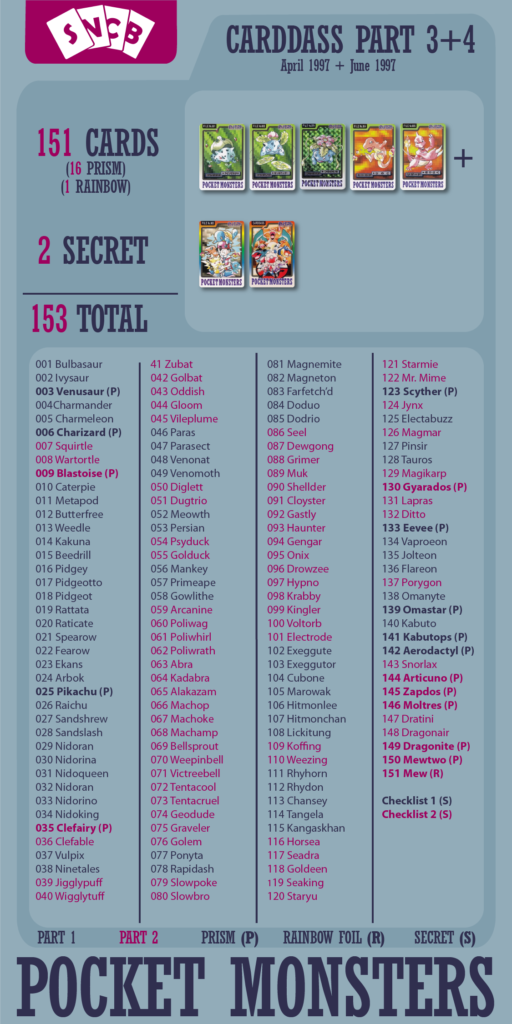
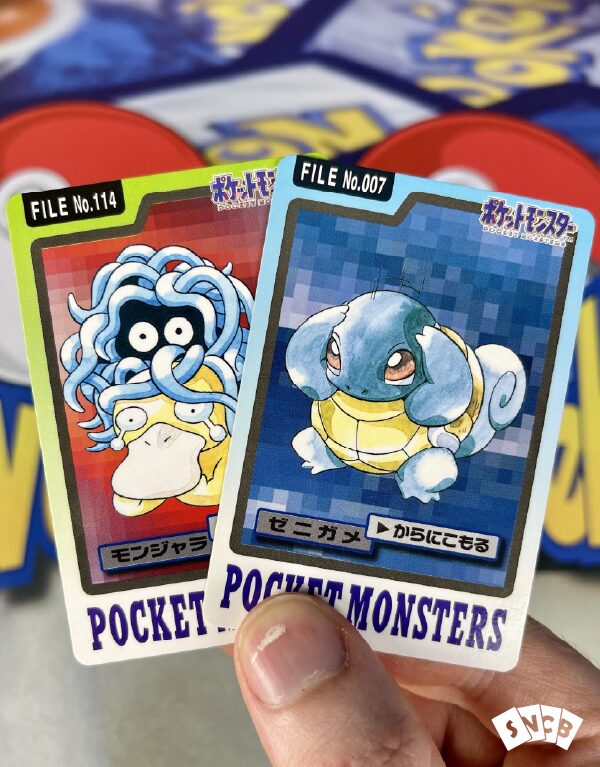
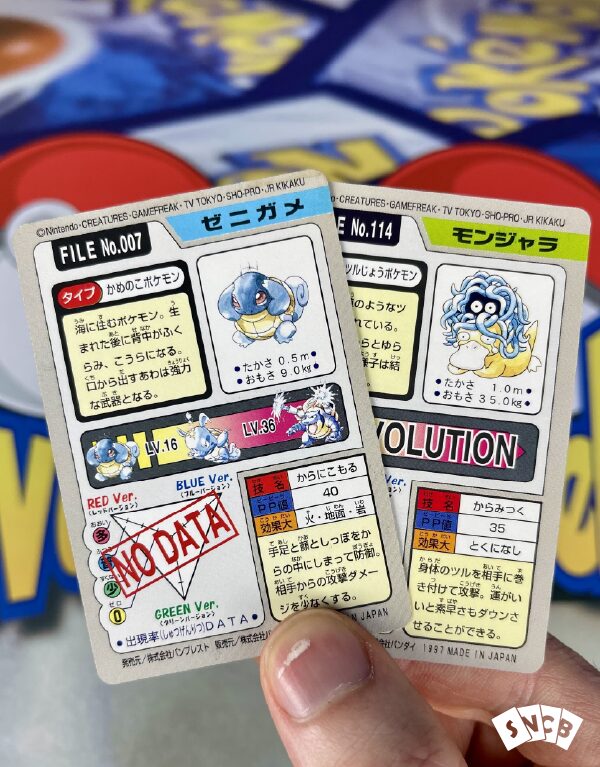
Part 3+4 Prism Cards
Part 3+4 only has 16 Prism cards and there is only one version of each. So rest assured that you only need to collect 16!
This time we get more of a variety of Pokémon, with some unlikely appearances such as Clefairy, Scyther, and Omastar.
Here is the list of Part 3+4 prism cards:
- Venusaur (Part 3)
- Charizard (Part 3)
- Blastoise (Part 4)
- Pikachu (Part 3)
- Clefairy (Part 4)
- Scyther (Part 3)
- Gyarados (Part 4)
- Eevee (Part 3)
- Omastar (Part 3)
- Kabutops (Part 3)
- Aerodactyl (Part 3)
- Articuno (Part 4)
- Zapdos (Part 4)
- Moltres (Part 4)
- Dragonite (Part 4)
- Mewtwo (Part 4)
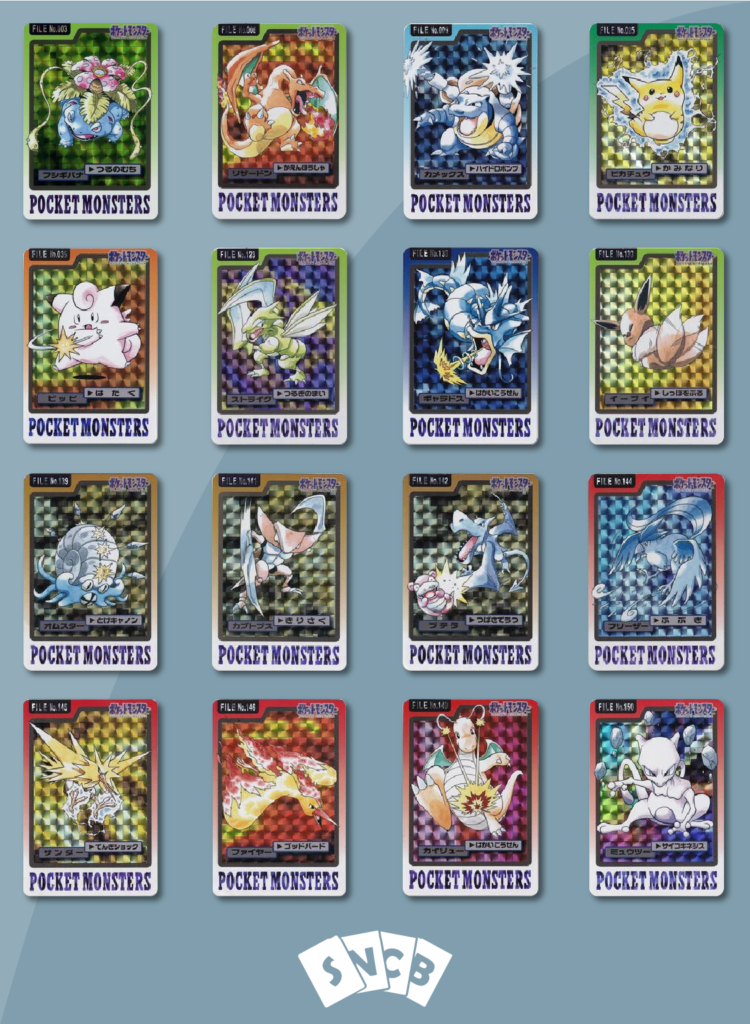
The Part 4 Rainbow Foil
The 1997 CARDDASS cards feature a unique Mew card with a different foil pattern.
This is the one and only Rainbow foil of any CARDDASS card so far and is sought after for that reason. To be clear, this is not a Prism foil, so Part 3+4 contains 16 Prism cards, plus one Rainbow foil.
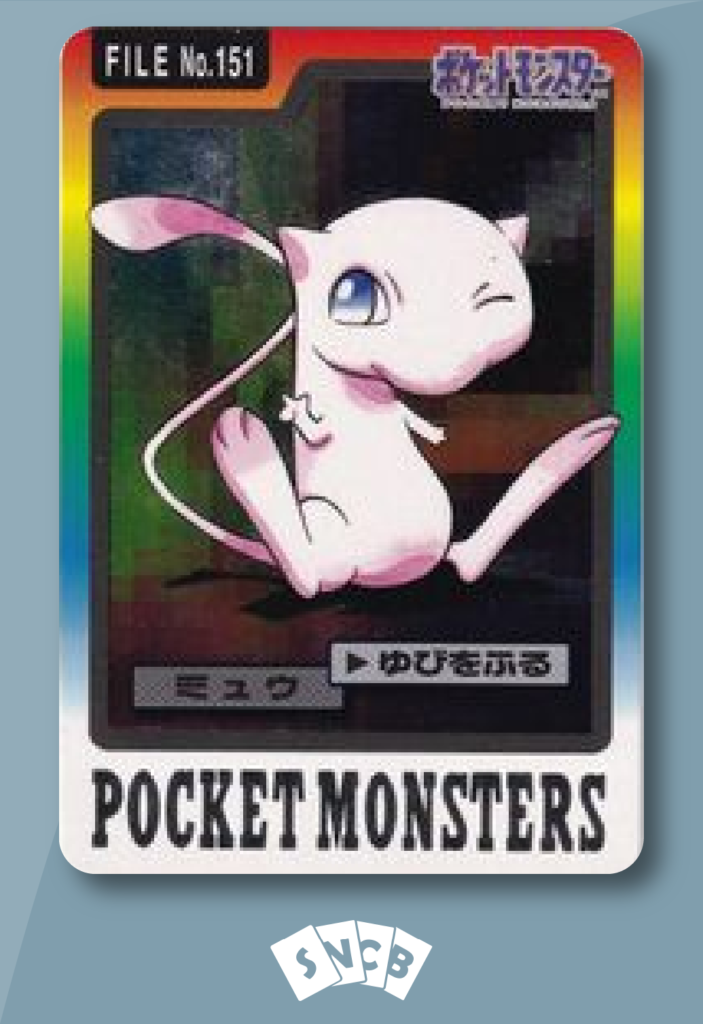
The Secret Cards
Part 3+4 of the CARDDASS cards have two secret cards added to the set. They have unique artwork featuring characters from the GameBoy games and have rainbow borders, which previously only applied to Mew from Part 4.
FILE No.000
The first secret cards feature Red with their four starter Pokémon. Artwork that was only reused once on one of the jumbo CARDDASS cards. This card was distributed in a Japanese department store called Ito-Yokado in April 1997.
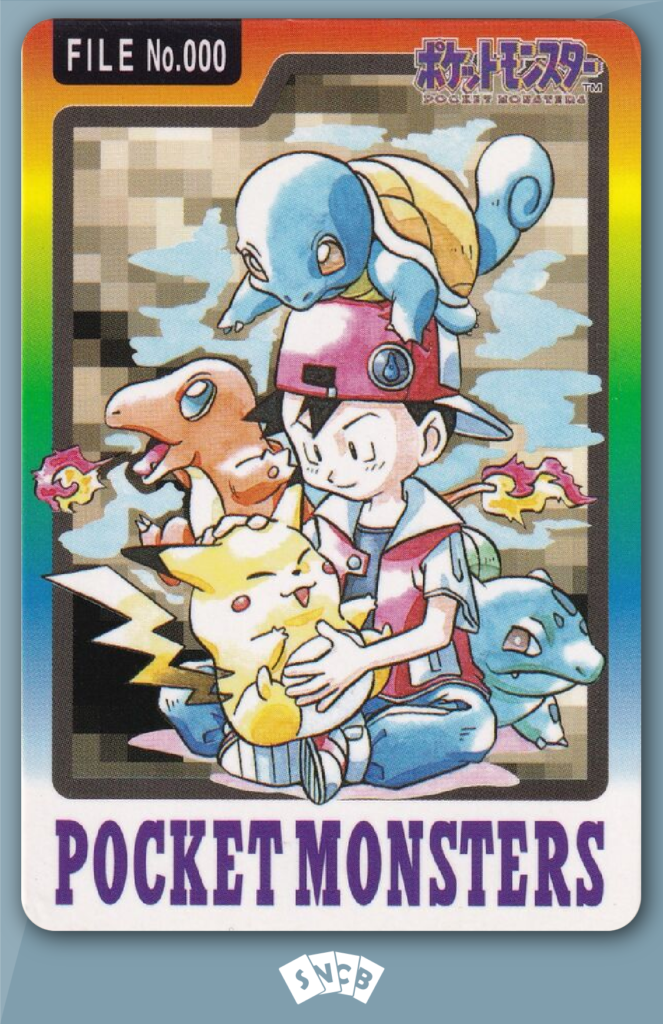
CARDDASS
The second secret card has no file number but instead reads ‘CARDDASS’ in the top left corner. The artwork features both Red and Blue with Venusaur, Charizard, and Blastoise behind them. Red is also holding what appears to be an upside-down Pokéball – certainly a product of the franchise’s early days.
This card was also promotional but this time it was only available through vending machines at the same Ito-Yokado store, in June 1997.
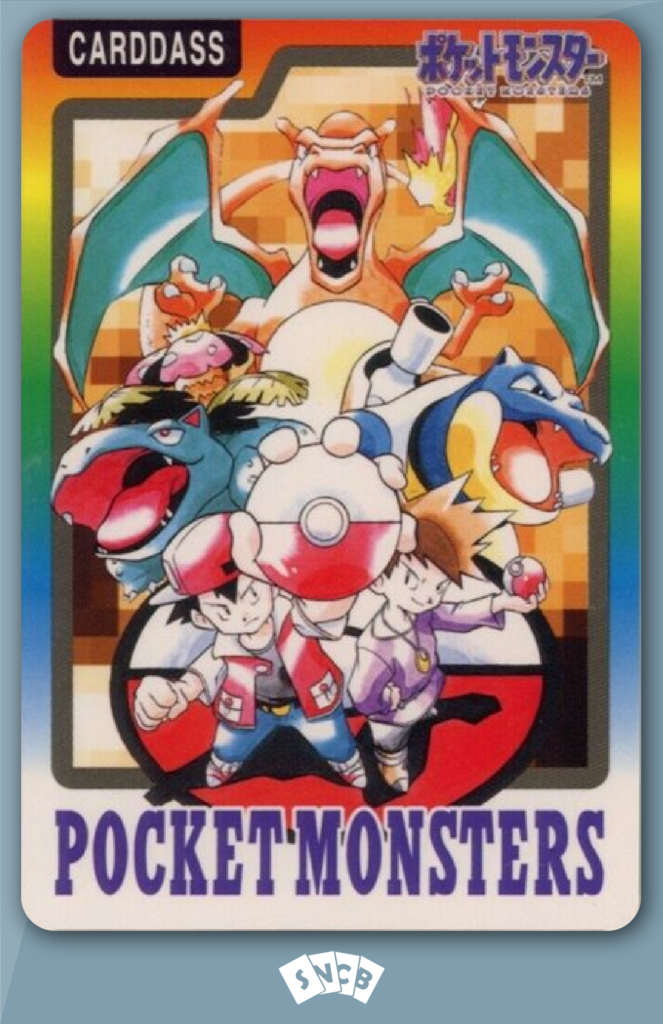
The Jumbo Cards
In November 1996, six jumbo-sized CARDDASS cards were released. On one side of the jumbo cards were various stickers. When all the stickers are peeled off, a special image or Sugimori illustration is revealed.
Two of the six jumbo cards have unique artwork on the reverse side. The other four have the ‘POKEMON TIMES’, a mini collection of Pokémon facts, stats, and a small comic.
In March 1997, a seventh jumbo card was released at the 1997 Tokyo Game Show. Possibly to promote the upcoming set.
This jumbo card was actually Pikachu, the FILE No. 025 card from Part 3+4 of the CARDDASS Pocket Monsters collection.
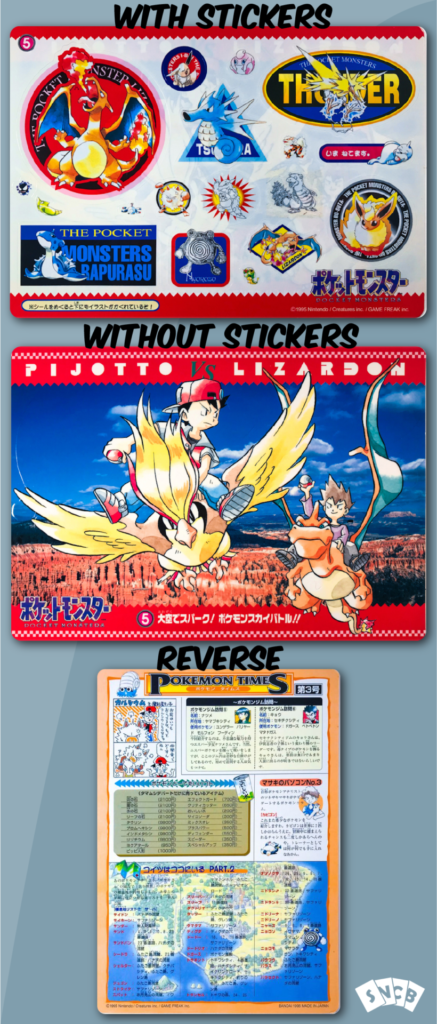
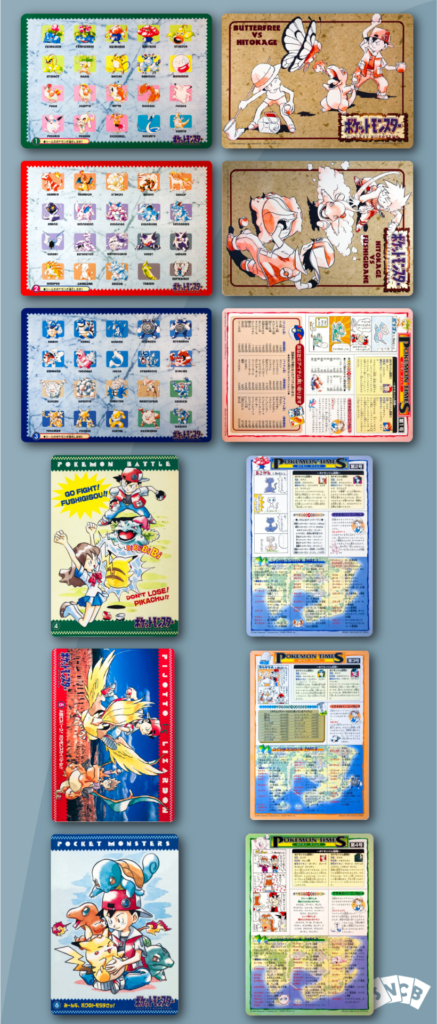
Benimaru Itoh Cards
Part 1+2 of the CARDDASS cards are said to only feature Ken Sugimori artwork, but this would be incorrect.
Of the 151 cards, 11 actually have a small illustration on the back by Benimaru Itoh. Itoh’s most recognizable illustration would be the promotional Mewtwo from the Pokémon TCG Black Star Promos.
His CARDDASS illustrations reflect the dark nature of his art style. The 11 cards with Itoh’s artwork are:
- Arbok – 024
- Pikachu – 025
- Jigglypuff – 039
- Polywhirl – 061
- Geodude – 074
- Slowbro – 080
- Doduo – 084
- Gengar – 094
- Drowzee – 096
- Horsea – 116
- Kabutops – 141
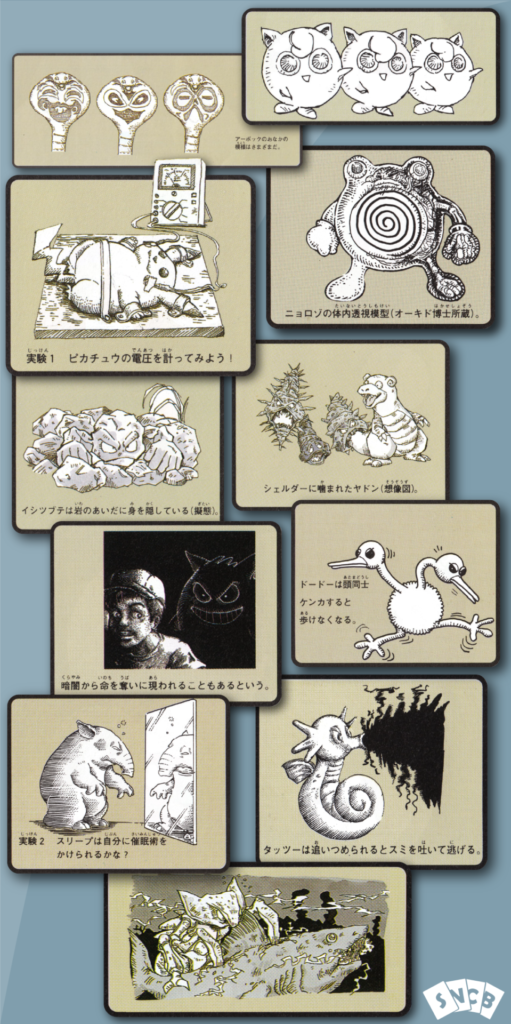
While most of the 11 illustrations are friendly, a few suggest that the Pocket Monsters are, in fact, monsters. Such as the Gengar, whose text, when translated, describes Gengar as “taking the life” of a child.
This artwork is fairly unknown, only appearing on these 11 cards, some of the stickers on the CARDDASS Jumbo cards, and in the ‘An Illustrated Book of Pocket Monsters”, a Pokédex guide published in Japan, in 1996.
These 11 cards (22 if you collect both Red and Green versions) are my favorite of the entire set and are still affordable if you would like to collect them for yourself.
Are Carddass Cards The First-Ever Pokémon Cards?
While the subject has been hotly debated in the past, it’s fairly definitive that the 1996 CARDDASS cards are the very first Pokémon cards to be released to the public.
The CARDDASS cards have a documented release date of September 1996, which precedes the October 1996 release of the Pokémon Trading Card Game (TCG).
It is sometimes argued that the TOPSUN cards were the first, but I’ve written about this extensively in another article, explaining that TOPSUN did not obtain the rights to Pokémon until 1997 and, therefore could not have released the cards before then.
However, it is important to note that the CARDDASS Part 3+4 was released in 1997, making them younger than the TCG. Only Part 1+2 of CARDDASS cards can be considered the first.
- September 1996 – CARDDASS Part 1+2
- October 1996 – The Pokémon Trading Card Game (Media Factory)
- March 1997 – TOPSUN
- April 1997 – CARDDASS Part 3 + 4
The jumbo CARDDASS cards may also be considered the first jumbo Pokémon cards ever since CoroCoro Magazine did not publish any jumbo cards until 1997.

How Much Are Pokémon Carddass Cards Worth Today?
I’ll start off by saying that CARDDASS cards are extremely undervalued today, and there are two main reasons for this:
- Misinformation – It still isn’t common knowledge that these cards were the first to be released.
- Lack of exposure – CARDDASS cards were never produced outside of Japan. In 1999, the TCG landed in North America and it quickly took over.
As a result, you can find most of the non-prism CARDDASS cards for under $5 on eBay. To get an even better deal, you can buy collections or ‘lots’ which end up saving you a few bucks per card.
So CARDDASS cards are still cheap, but there are exceptions.
Prism cards – The prism cards are highly sought after, especially Charizard. And this doesn’t really differ between Part 1+2 or Part 3+4. If you want the prism cards, you’ll have to dish out some cash.
Secret cards – The two promotional secret cards featuring Red and his Pokémon are not cheap. These cards had a limited supply and given the amazing artwork, have a high demand.
The Jumbo Pikachu – The first six jumbo cards are costly, but the jumbo Pikachu is a whole different ball game. This card is not only hard to find but often goes for $1,000+ on eBay.
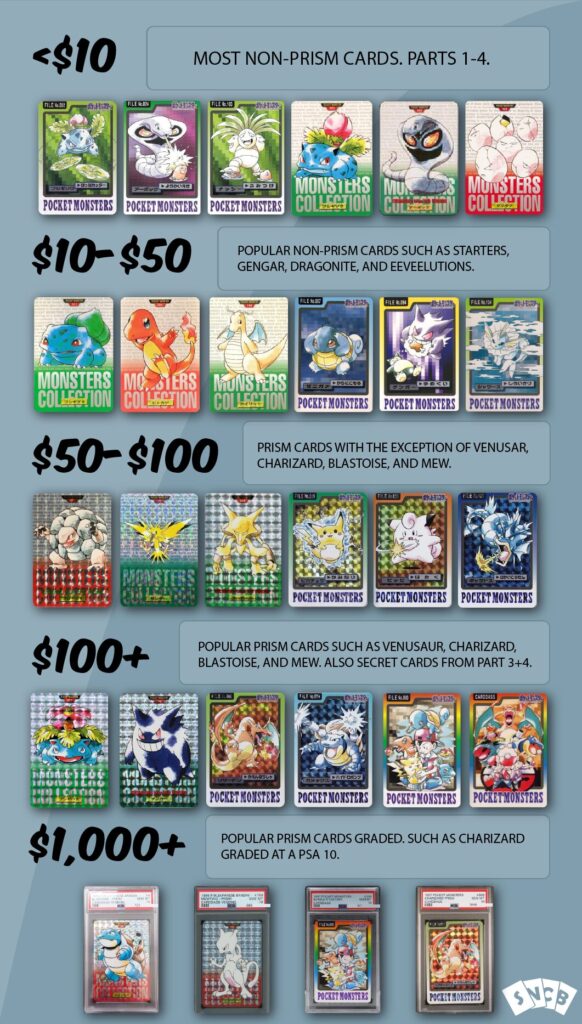
The Most Valuable CARDDASS Card
It’s Charizard.
This trend of Charizard being the most expensive card isn’t new or unexpected. As always, buying these cards now is a good investment opportunity. These really are the ‘rookie’ cards of Pokémon and one day the market will catch up.
Some people believe that the ‘No Rarity’ Charizard from the Japanese Base Set is the first ever Charizard too. Personally, I believe that the CARDDASS Charizard will one day reach a similar status and sale price.
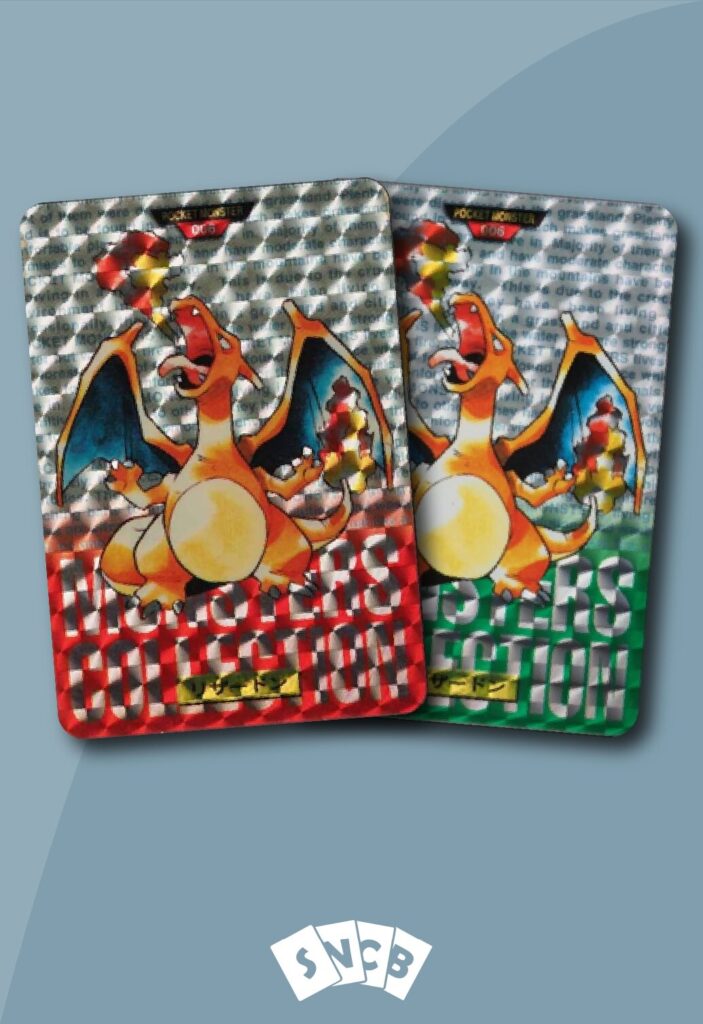
Final Thoughts
The Pokémon CARDDASS cards from 1996 and 1997 are truly some of the most unique and collectible pieces of vintage Pokémon culture today. There is a lot of evidence to support that these were the first ever Pokémon cards to be released, however, they are still undervalued.
I put a lot of error into this article because these cards inspired me to do so. The original Sugimori artwork exclusive to this set gives me tingles of nostalgia that cannot be matched.
If this is your first deep-dive into the CARDDASS cards, then welcome, and hopefully, they bring you as much joy as they do me, and others.
